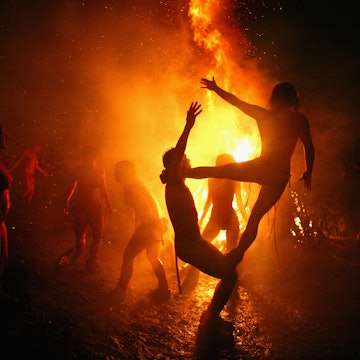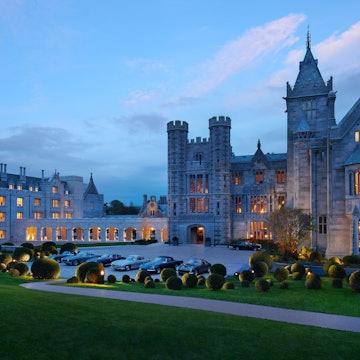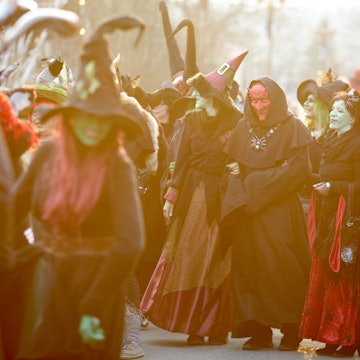
Pagan festivals from around the world and how to celebrate them
Oct 8, 2025 • 11 min read

The decorated Burryman being led down the street in South Queensberry. Euan Cherry/Shutterstock
Paganism is experiencing a global revival as more people seek a reconnection with nature and to protect our fragile ecosystem. Numerous destinations such as New Orleans, US; Edinburgh, Scotland; and Drogheda, Ireland, have commercialized their pagan festivals to attract visitors from around the globe. However, there are still places where ancient celebrations continue in their original form, preserved as locally kept secrets passed down through generations.
These festivals preserve age-old customs, which often originate from traditions and practices that predate the arrival of Christianity. While the more serious pagan festivals observed today consist of Mabon and Yule, these five lesser-known celebrations are an excellent opportunity to experience the culture of the local community and gain insights into pagan tradition.
1. The Burryman Procession, South Queensferry, Scotland
Covered entirely in prickly burdock seedheads and adorned with a crown of flowers, the Burryman and his procession of bagpipe players and bell ringers have walked the streets of South Queensferry every August for over nine hundred years, making this the oldest festival in Scotland. The oldest official record of the Burryman Festival goes back to 1687, when the event was officially recognized. Although the meaning behind this tradition is unknown, the Burryman is believed to be the Scottish interpretation of the Green Man, a pagan nature spirit representing rebirth and fertility, and whose presence wards off evil.
Only a male born in South Queensferry can become the Burryman. Considered a great honor, those selected often hold the position for many years. In the weeks leading up to the procession, the chosen man must hand-pick the thousands of burrs that will be used for his costume. The burrs are then stuck on to fabric panels, and on the morning of the big day, the panels are carefully applied to the man until he is fully engulfed in a suit of burrs. The Burryman is aided by a team of assistants, who keep his arms propped up on decorated staffs and escort him as he hobbles slowly through the town, a journey that lasts for nine hours. Along the way, onlookers bestow the Burryman with gifts of money and drams of whisky so that he will bring them good luck.
Where and when is the The Burryman Procession?
The Burryman Procession is held on the second Friday in August in South Queensferry, Scotland.

2. Fêtes de L’Ours (Festival of the Bears), Pyrénées-Orientales, France
Symbolic of the age-old struggle between man and nature, the wild tradition of the Fêtes de L’Ours has been held in Pyrenees villages for centuries, tracing its origins back to the arctolatry (bear worship) practiced by pre-Christian Basques. In Prats-de-Mollo-la-Preste, host to the oldest of the bear festivals, participants reenact the legend of a young shepherdess kidnapped by a lecherous bear. The young girl prayed for protection of her virtue to the nearby Notre Dame du Coral cathedral, which greatly displeased the bear. For nine days he howled in revulsion outside of his cave, attracting the attention of nearby woodcutters, as well as a farm boy and the hermit of Notre Dame du Coral. While the farm boy and the hermit came to the shepherdess’ rescue, the woodcutters tracked down and killed the bear.
The festival begins at Fort Lagarde on the hill above the village, where a feast is held for the men who have been chosen to play the bears. The chosen are then sewn into sheepskin costumes, and every visible patch of skin is covered with a thick mixture of oil and soot. Wielding long wooden staffs, the costumed bears let out a deafening roar and race down the hill, tackling people – women seem to attract the most attention – along the way, smearing their victims with soot. Down into the village’s winding maze of cobbled streets, the bears are pursued by hunters into the village square, where they are finally chained up and “shaved,” returning to their human forms. The festivities close with people dancing in a frenzy until someone lets off a single gunshot, signaling the festivities are coming to a close.
Where and when is the Festival of the Bears?
The Fêtes de L’Ours is held on the second Sunday in February in Prats-de-Mollo-la-Preste, France. Be sure to wear old clothes – chances are you'll end up covered in soot!
3. Harvest Home, Whalton, England
Until about one hundred years ago, it was a common practice in rural communities throughout the United Kingdom to celebrate a bountiful harvest with a ritual known as the Harvest Home. At the end of the season, the last of the corn sheaves would be cut down and fashioned into the likeness of a woman, known as the Kern Baby. Dressed in an elegant white gown, ribbons and flowers woven into the ears of corn bursting from her head, the Kern Baby would be hoisted onto the top of a large pole; the community would gather round and dance below the effigy, then enjoy a great feast – farmers and laborers sharing the same table.
The tradition of the Harvest Home is believed to have originated in ancient Rome. In honor of Ceres, the goddess of agriculture, farmers would weave dolls out of the last of the gathered corn and display them in their fields. The dolls served as vessels to hold Ceres after the fields were reaped so that her spirit would not go astray.
Today, the village of Whalton in northern England is the last stronghold of this ancient custom, holding a bonfire – or Baal fire – to mark the end of the harvest, and since 2016 it has been home to a 15ft Kern Baby. The festival, in addition to having many of the trappings you’d expect from a harvest festival, also typically has classic car exhibits and other fascinating displays.
Where and when is the Harvest Home festival?
The Baal Fire and Kern Baby dance are held on July 4 in Whalton, England.

4. Fasnacht, Kriens, Switzerland
During the month of Lent, Switzerland comes alive with a wild cacophony of masquerades, pageants and marching bands, dispelling the oppressive spirits of winter and allowing for one last indulgence before fasting begins on Ash Wednesday. Carnival – or Fasnacht – has been celebrated in Switzerland for centuries, and although modern Fasnachts favor elaborate costumes and pop culture motifs, historically participants wore old clothes and simplistic hand-carved wooden masks. The festival dates back to 1376 and is a recognized cultural event by UNESCO.
The city of Kriens has preserved these masking traditions. The earliest known Kriens masks – or Hübelimasken – date back to the eighteenth century and were crudely made with rudimentary features. The Hübelimasken became more sophisticated over time and began combining pagan symbolism with caricatures of common figures from the region. This eventually led to the creation of the four beloved characters unique to the Kriens Fasnacht: “Wöschwyb” – the washerwoman; “Krienser Deckel” – the French soldier; “Buuremaa” – the farmer; and “Bärnerwiib” – the Bernese courtesan.
Each character has its own distinct personality: the cheeky Wöschwyb likes to gossip, while the lascivious Bärnerwiib lifts up her skirts and purrs at the crowd. The Krienser Deckel, with his elongated hat of red-painted tree bark, plays the dual role of villainous soldier and forest spirit, while the grumpy Buuremaa stomps along the parade route, frightening onlookers. In the past, only men were involved in Fasnacht, but now all genders are allowed to participate.
Where and when is Fasnacht?
Fasnacht is held between Dirty Thursday and Carnival Tuesday, prior to Ash Wednesday, in Kriens, Switzerland.
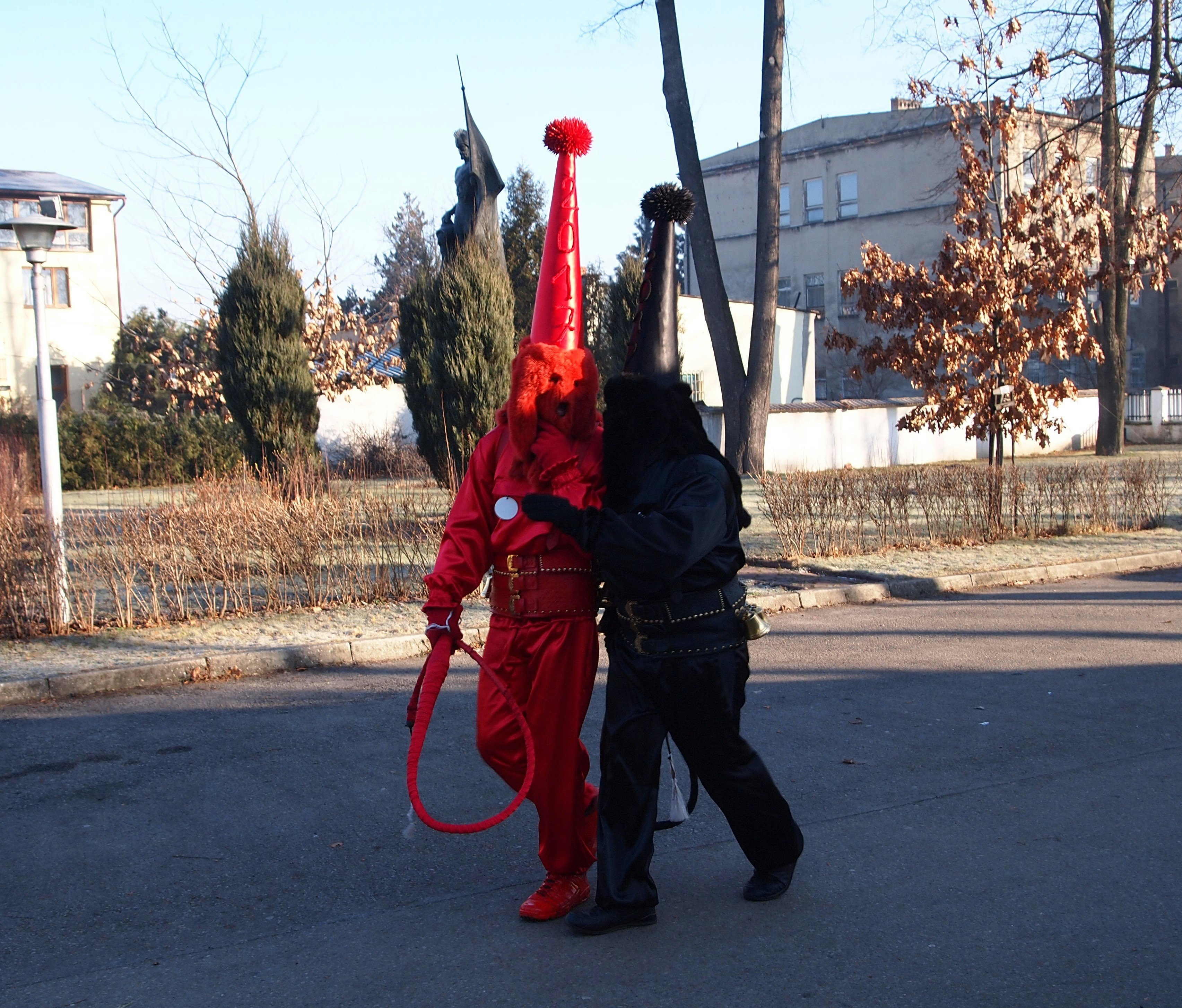
5. Gody Zywieckie, Zywiec, Poland
In the pre-dawn dark on New Year’s day, in the mountain town of Zywiec, a troop of colorfully dressed men in conical hats and sheepskin masks race along the streets. These men are known as the Grandfathers – or Jukace – come to usher in the festivities of Gody Zywieckie, an ancient Slavic-pagan masquerade, heralding the end of winter.
The Jukace begin running on New Year’s Eve, going from party to party, accepting gifts of vodka, sweets and money in return for good blessings. After attending a 5am Mass, the Jukace resume their sojourn around the city, jumping, dancing and cracking their whips, embracing passersby and shouting well-wishes into the cold morning air. Gody Zywieckie culminates at noon with a parade in the center of the city.
The Jukace are seen as figures of good luck, their running symbolic of chasing away bad spirits and the old year. However, the origins of the characters are unknown. A popular local legend is that during the Deluge of 1655, Zywiec Highlanders dressed up as monsters and charged down the mountainside, frightening the invading Swedish army with their otherworldly looks and the crack of their whips, and allowed King John II Casimir of Poland to escape.
To become a Jukace is an arduous process; prospective applicants start as young as eight years old and work their way up the ranks of masquerade characters – Babka (old woman), Chimney Sweep, Imp – to become a Jukace. Even then, only bachelors are eligible and must undergo tests for strength, agility and memory to determine whether or not they are right for the role.
Where and when is Gody Zywieckie?
Gody Zywieckie is celebrated on New Year’s Eve and New Year’s Day in Zywiec, Poland.

Pagan festivals: dates, tips and etiquette
What dates do pagans observe for celebration and worship?
There is no single source of truth for pagan holidays and ritualistic celebrations. Just like there is some discrepancy between various Christian sects over the observance of Christmas, with some celebrating the holiday in January and not December, there are also discrepancies over what holidays are observed and when pagans celebrate them. But, you can use the Wheel of the Year as a general guide as to when and how pagans choose to practice their faith on their holidays.
The Wheel of the Year divides the calendar into eight key points, such as Imbolc, Litha, Samhain and Yule. Each celebration honors the changing seasons, nature and the spirits surrounding us. For travelers seeking to experience rich, time-honored traditions, these festivals provide a meaningful connection to history and the natural world.
Several smaller festivals and celebrations are within these larger occasions, such as Imbolc and Samhain. Imbolc is typically observed in early February, while Samhain is observed on what most people call Halloween, October 31st. These major holidays are known as Greater Sabbats (the pagan word for a holiday), while the solar festivals are known as Lesser Sabbats, which include Ostara and Yule.
In 2026, the major holidays of the pagan Wheel of the Year will fall on the following dates:
Imbolc (Candlemas): February 1st
Ostara (Spring Equinox): March 20th
Beltane (May Day): May 1st
Litha/Midsummer: June 21st
Lammas (Lughnasadh/Lughnasa): August 1st
Mabon (Fall Equinox): September 23rd
Samhain (All Hallows): October 31st
Yule (Winter Solstice): December 21st

Between these holidays are several small festivals and feast days, which can be location-specific or tied to pre-Christian cultures. But these less prominent festivals aren’t as universally recognized as the major pagan holidays listed above and are more obscure and locally observed.
Some of these celebrations include the following:
Tschäggättu, Switzerland
Rauhnacht, Germany
Dionysia, Greece
Saturnalia, Rome/Greece
While many of these festivals are originally from Europe, many communities across the globe choose to add these celebrations to their pagan calendar.
Are Pagan festivals open to anyone who wants to participate?
In most instances, anyone who wishes to attend a pagan event, festival or Sabbat is welcome to join. In fact, many Wiccans and neo-pagan groups like to have new people come to their events because it dispels some of the rumors that surround their practices. Newbies can find groups hosting meet-ups on social media, blogs and other online media, and there aren’t any strict rules you need to follow to attend most meetings.
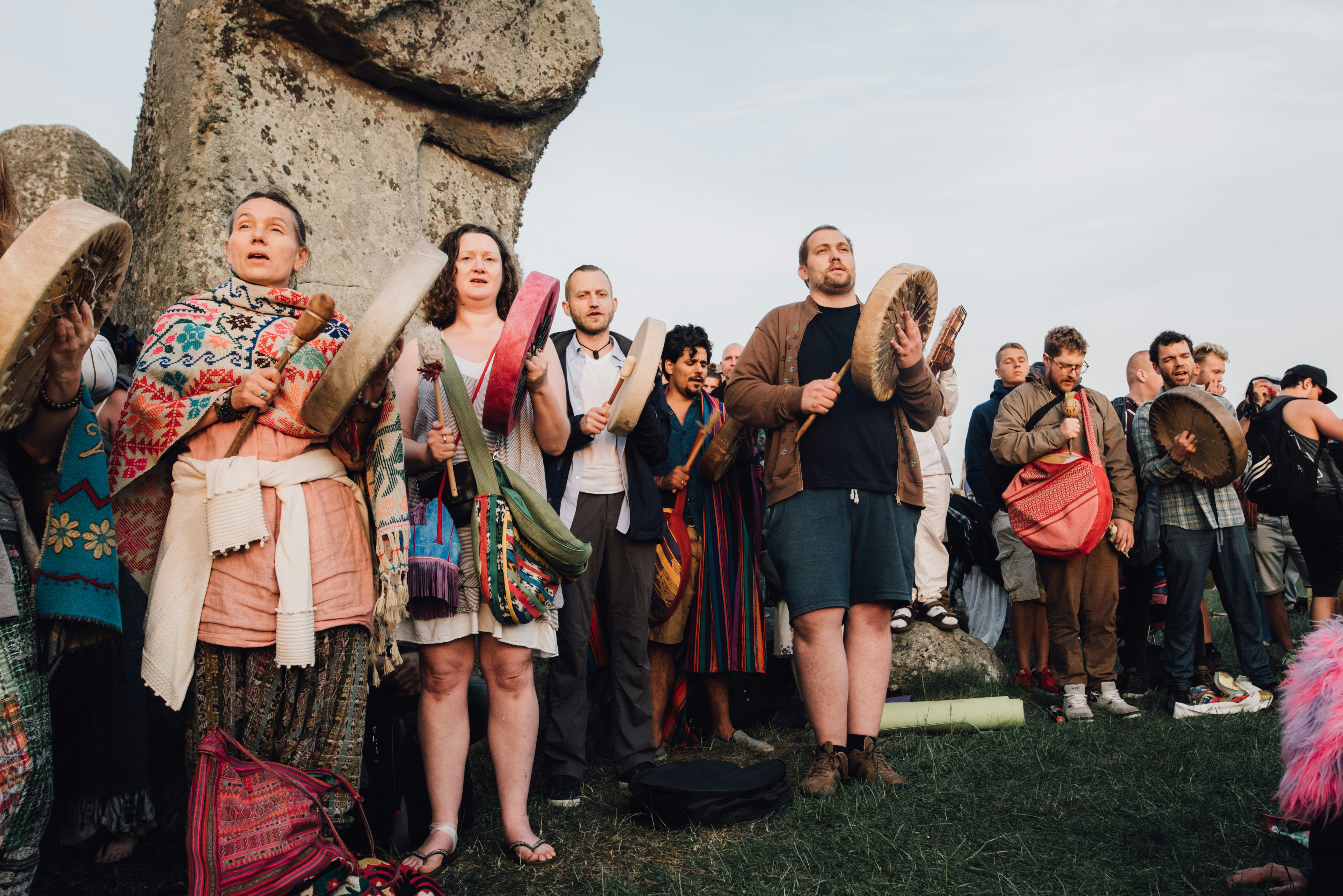
What do I need to know about pagan festival etiquette?
Respect is essential in pagan communities, and many practitioners place great value on the principle of asking for permission. For most pagans and Wiccans, a central tenet of their belief is: “Do what you will, as long as it harms none.” This guiding philosophy encourages personal freedom but also emphasizes the importance of mindfulness and consideration for others and the natural world.
So when planning to visit a pagan festival or sabbat, it’s smart to keep a few things in mind, so you can be respectful:
Always ask permission: never touch someone else’s magic or ritualistic items. This could be their crystals, wands, crystal balls, tarot cards or any other items they have with them. Many pagans believe these devices have special powers and can become contaminated when others handle or use them.
Be honest: pagan communities appreciate honesty. They want you to speak up and not feel pressured to do something you're uncomfortable with.
Protect their privacy: paganism is growing in popularity around the globe, but it's still on the fringes of society. Some pagans are open about their faith, but many still worry about how their religion may impact their lives. When and if they pronounce their faith to the world is their decision, so never share the identity of a pagan unless they tell you you can.








